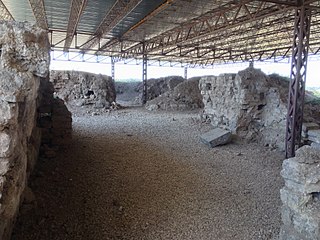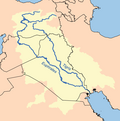
Nineveh, also known in early modern times as Kouyunjik, was an ancient Assyrian city of Upper Mesopotamia, located in the modern-day city of Mosul in northern Iraq. It is located on the eastern bank of the Tigris River and was the capital and largest city of the Neo-Assyrian Empire, as well as the largest city in the world for several decades. Today, it is a common name for the half of Mosul that lies on the eastern bank of the Tigris, and the country's Nineveh Governorate takes its name from it.

The Hurrians were a people who inhabited the Ancient Near East during the Bronze Age. They spoke the Hurrian language, and lived throughout northern Syria, upper Mesopotamia and southeastern Anatolia.

Mitanni, earlier called Ḫabigalbat in old Babylonian texts, c. 1600 BC; Hanigalbat or Hani-Rabbat in Assyrian records, or Naharin in Egyptian texts, was a Hurrian-speaking state in northern Syria and southeast Anatolia with Indo-Aryan linguistic and political influences. Since no histories, royal annals or chronicles have yet been found in its excavated sites, knowledge about Mitanni is sparse compared to the other powers in the area, and dependent on what its neighbours commented in their texts.

Nuzi was an ancient Mesopotamian city southwest of the city of Arrapha, located near the Tigris river. The site consists of one medium-sized multiperiod tell and two small single period mounds.

Alalakh is an ancient archaeological site approximately 20 kilometres (12 mi) northeast of Antakya in what is now Turkey's Hatay Province. It flourished, as an urban settlement, in the Middle and Late Bronze Age, c. 2000-1200 BC. The city contained palaces, temples, private houses and fortifications. The remains of Alalakh have formed an extensive mound covering around 22 hectares. In the Late Bronze Age, Alalakh was the capital of the local kingdom of Mukiš.

Aššur (; Sumerian: 𒀭𒊹𒆠 AN.ŠAR2KI, Assyrian cuneiform: Aš-šurKI, "City of God Aššur"; Syriac: ܐܫܘܪ Āšūr; Old Persian: 𐎠𐎰𐎢𐎼 Aθur, Persian: آشور Āšūr; Hebrew: אַשּׁוּר ʾAššūr, Arabic: اشور), also known as Ashur and Qal'at Sherqat, was the capital of the Old Assyrian city-state (2025–1364 BC), the Middle Assyrian Empire (1363–912 BC), and for a time, of the Neo-Assyrian Empire (911–609 BC). The remains of the city lie on the western bank of the Tigris River, north of the confluence with its tributary, the Little Zab, in what is now Iraq, more precisely in the al-Shirqat District of the Saladin Governorate.
Tushhan was a Neo-Assyrian provincial capital in the upper Tigris region. It was rebuilt by the ruler Ashurnasirpal II and survived until the end of the Neo-Assyrian period around 611 BC.

Tell Fekheriye is an ancient site in the Khabur river basin in al-Hasakah Governorate of northern Syria. It is securely identified as the site of Sikkan, attested since c. 2000 BC. While under an Assyrian governor c. 1000 BC it was called Sikani. Sikkan was part of the Syro-Hittite state of Bit Bahiani in the early 1st millennium BC. In the area, several mounds, called tells, can be found in close proximity: Tell Fekheriye, Ras al-Ayn, and 2.5 kilometers east of Tell Halaf, site of the Aramean and Neo-Assyrian city of Guzana. During the excavation, the Tell Fekheriye bilingual inscription was discovered at the site, which provides the source of information about Hadad-yith'i.
Tell al-Rimah is an archaeological settlement mound, in Nineveh Province (Iraq) roughly 80 kilometres (50 mi) west of Mosul and ancient Nineveh in the Sinjar region. It lies 15 kilometers south of the site of Tal Afar.
Tell Billa is an archaeological site near Bashiqa in Nineveh Province (Iraq) 20 kilometers northeast of Mosul.
Tell Shemshāra is an archaeological site located along the Little Zab in Sulaymaniyah Governorate, in the Iraqi Kurdistan autonomous administrative division of Iraq. The site was inundated by Lake Dukan until recently.
Bassetki is a small village in Iraq, in Dohuk Governorate of autonomous Kurdistan Region. The village is associated with several archaeological finds.
Bakr Awa is a tell, or archaeological settlement mound, in Sulaymaniyah Province, Iraq. It is located near Halabja in the Shahrizor Plain in Iraqi Kurdistan. It is in the foothills of the Zagros Mountains not far from the headwaters of the Diyala River. The site is 40 meters high and consists of a central settlement mound surrounded by a lower city measuring 800 by 600 metres. Other sites in the area include Tell Kunara, Tell Bazmusian, and Tell Shemshara.
Mardaman was a northern Mesopotamian city that existed between ca.2200 and 1200 BC. It was uncovered in 2018 after translation of 92 cuneiform tablets. The tablets were discovered in summer 2017, near the Kurdish village of Bassetki, by a team of archaeologists. The team hailed from Tübingen's Institute for Ancient Near Eastern Studies, and were led by Prof. Dr. Peter Pfälzner of the University of Tübingen. The city-god of Mardaman was the Hurrian goddess Shuwala. After the time of Assyrian occupation it is uncertain if this continued. It is thought that later in the 1st millennium BC a temple of Gula was at Mardaman.
Tall Bazi, is an ancient Near East archaeological site in Raqqa Governorate of Syria in the same general area as Mari and Ebla. It is located on the east bank of Euphrates river in upper Syria, about 60 kilometers south of Turkey border. It is considered a twin site to the adjacent Tell Banat Complex. Both were occupied in the 3rd and 2nd millennium BC with Banat being the focus in the early part and Bazi in the later. Tall Bazi has been proposed as the location of Armanum, known from texts of Sargon and Naram-Sin in the Akkadian period, during the reign of Naram-Sin of Akkad. It was occupied into the Mitanni period, with an occupational gap after c. 2300 BC, at which time it was destroyed. In the Late Roman Empire a large building was constructed at the top of the main mound, using the remaining Late Bronze Age fortification walls.
Tall Al-Hamidiya is an ancient Near Eastern archeological site the upper Hābūr region of modern-day Syria in the Al-Hasakah Governorate on a loop of the Jaghjagh River. It is located just to the north of the site of Tell Barri, just to the east of the ancient site of Tell Arbid, just to the west of Tell Farfara and 20 kilometers north of Tell Brak. It has been suggested as the location of Ta'idu/Taite. If so, it was mentioned as Ta'idu in early 2nd millennium BC Ebla and Mari texts. Later it was a provincial capital of the Middle Bronze Age Mitanni Empire. This identification is based primarily on a few Middle Assyrian Neo-Assyrian sources, as Taite, and the proximity of Kahat, known to have been nearby. Other locations have been proposed for Ta'idu/Taite.
Tell Yelkhi, is an ancient Near East archaeological site in Diyala Governorate (Iraq). It was examined as part of the Hamrin Dam salvage excavation before it flooded. Other sites a part of that rescue excavation included, Me-Turan, Tell Gubah, Tell Songor, Tellul Hamediyat, Tell Rubeidheh, Tell Madhur, Tell Imlihiye, Tell Rashid, Tell Saadiya and Tell Abada. Some of these sites, including Tell Yelkhi, periodically emerge from the water. The site of Tell Yelhi was settled in the early 3rd millennium BC and occupation continued through the Kassite period late in the 2nd millennium BC. Its name in ancient times is not yet known though Awalki has been suggested.
Üçtepe Höyük, is an ancient Near East archaeological site in Diyarbakır Province, Turkey about 40 kilometers southeast of the modern city of Diyarbakır and about 10 kilometers southwest of modern Bismil. The village of Üçtepe is nearby. It was occupied from the Late Early Bronze Age until the Roman period and is notable as the discovery location of the Kurkh Monoliths. The ancient site of Ziyaret Tepe lies 22 kilometers to the west. Other archaeological sites in the area include Pir Hüseyin, Kenan Tepe, Hirbemerdon Tepe, Salat Tepe, Giricano, and Sahin Tepe.
Tell al-Hawa is an ancient Near East archaeological site on the North Jazira Plain of northern Iraq, near the border with modern-day Syria and just west of the Tigris river. It lies 40 kilometers southwest of the site of Tell Hamoukar and about 90 kilometers northwest of modern Mosul. Occupation at the site began in the 5th millennium BC Halaf period and continued, with periods of abandonment, until the Islamic period. Settlement reached a substantial size in the 4th millennium BC Uruk period and the late 3rd millennium BC Akkadian Empire period. A modern village, 26 hectares in size, lies off the east edge of the main mound. Tell al-Hawa was excavated as part of a regional rescue archaeology program resulting from the completion of the Mosul Dam and the subsequent expansion of irrigated agriculture. Beveled rim bowls, diagnostic of the Uruk Culture, were found at the site.








